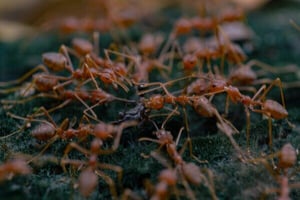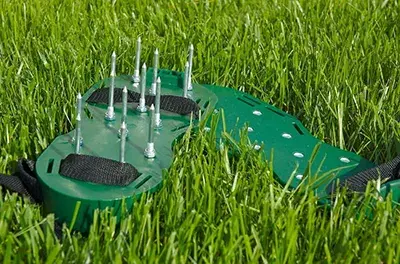Common Texas
Pests & Prevention
Texas lawns are home to more than just St. Augustine, Bermuda, Zoysia, and Buffalo grass—they also attract pests like fire ants, grubs, chinch bugs, armyworms, and sod webworms. These insects can cause brown patches, thinning grass, and lasting damage. Prevent infestations with regular lawn care, proper watering, and professional treatments. If you notice chewed blades or increased insect activity, targeted pest control can help keep your lawn healthy, green, and pest-free.
Pest Control Tips
Lush and healthy lawns start with your outdoor space and surrounding environment. However, optimal soil conditions and regular lawn maintenance may not be enough to guarantee your lawn will thrive, especially when you have an untreated pest problem. These unwanted bugs can negatively affect your lawn’s aesthetic appeal and impact your turf’s health.
Pest control is only effective if you address the factors that attract insects and rodents to your property. Here are some pest control tips to help you maintain your lawn.
What Are the Common Lawn Insects in South, Central & North Texas?
There are approximately 100,000 types of insects native to the United States, and a third of them can be found in Texas. According to the Texas Parks and Wildlife Department, the Lone Star State is home to more insects than any other state.
Because of the area’s climate and soil conditions, these particular insects tend to be a common concern in most homes:
Armyworms
Armyworms are destructive caterpillars most active in late summer and early fall, but they can be found in your lawns as early as spring and summer. They are often introduced through new sod or infestations from your neighbor's land that’s spread to your property. It takes 28 days for armyworms to grow from egg to adult, so untreated spaces can be overrun by several generations quickly. Armyworms create irregular brown patches on lawns. Unlike grubworms, which attack the roots, adult armyworms eat grass stems while small larvae chew on the green layer responsible for photosynthesis. This can weaken your turf and make it vulnerable to outdoor conditions

Grubs
Grubs are the larvae of various beetle species. Their presence and impact on lawns are most severe in the late summer and early fall when they hatch and are actively feeding. After hatching underground, they move closer to the surface as they mature. As a result, they start feeding on the root systems of your grass, which causes your turf to turn brown, die, and detach from the soil, peeling away easily like a carpet. Additionally, grubs are natural prey for rodents and armadillos. An infestation of grubs can lead to wildlife burrowing around your property, causing more damage.

Chinch Bugs
Chinch bugs are tiny pests that thrive in hot, dry conditions typical of the Texas climate. They prey on thick grass types (like St. Augustine) by sucking the juices from the grass blades and injecting toxins that kill the grass, leaving yellow or brown patches that expand if untreated. Adult cinch bugs have slate-black bodies with silvery wings. However, their size makes them difficult to see and diagnose. This can result in costly damage due to delays or incorrect and ineffective treatments.

Fleas
Fleas are a year-round problem in Texas, as the winter temperatures are not low enough to stop flea activity. Lawn fleas typically live for 100 days and take 45 days to grow from egg to adult. With the average adult female laying about 40 eggs daily, you can imagine how easily fleas can infest your property. Fleas pose threats to pets, households, and wildlife. Most pets become infested by roaming outdoors, resulting in itchy bites and irritation. Fleas can also transmit diseases and tapeworms, making them a growing health concern in many southern states.

Fire Ants
Fire ants are aggressive species of ants known for their painful stings – and severe allergic reactions in some individuals – making them a threat to humans and pets. Fire ants are highly territorial and can quickly spread across a yard if left untreated. One colony can have several queens, with one queen laying up to 800 eggs daily and up to half a million worker ants. A single queen only needs about six worker ants to establish a brand new colony. Within a short time (sometimes even overnight), this new colony can grow rapidly, leading to a larger infestation in your yard

What Are Some Effective Pest Control Tips for Texas Homes?
Pest control is an ongoing process — especially in areas like Texas. Unfortunately, many homeowners mistake insect damage for lawn diseases, resulting in irreparable damage. Here are some pest control tips to ensure your outdoor spaces remain safe and healthy from pest infestations.
- Regularly empty birdbaths, buckets, and plant saucers.
- Ensure gutters and drains are clear.
- Check your irrigation system for leaks.
- Aerate your lawn if you see signs of soil compaction.
- Install permeable hardscaping, such as gravel and pavers.
Maintain Your Lawn: Pests like ticks, fleas, and mosquitoes are attracted to poorly maintained yards because they provide shelter and food sources. Keep grass trimmed, remove weeds, and rake up leaves.
Use Mulch Wisely: Avoid piling mulch too close to your home’s foundation, as it can attract pests like ants. Keep a gap of at least six inches between mulch and structures.
Remove Food and Organic Waste: Garbage cans, compost piles, and other sources of organic waste can attract flies, ants, and rodents. Some practices to keep in mind:
- Keep garbage and compost bins sealed.
- Regularly clean your garbage cans to avoid developing odors that can attract pests.
- Dispose of pet waste properly.
Hire Professional Pest Control Services: With professional pest control services, you can address persistent or severe pest problems. Regular treatments scheduled at the best times can ensure long-term protection for your outdoor spaces.
- Live oaks
- Texas mountain laurels
- Yaupon hollies
- Crape myrtles or vitex trees can adapt to Texas’ environmental conditions
FAQs About Emerald Lawn’s Pest Control Services
FAQS
Answer: Emerald Lawns provides pest control solutions for various insects and rodents. If your lawn or yard has a pest problem, we invite you to contact us to discuss your needs in detail.
We provide pest control for the following:
- American Roaches
- ants of all species
- sow and pill bugs
- non-grain or cloth-feeding beetles
- boxelder bugs
- assassin bugs
- centipedes
- millipedes
- mud-daubers
- scorpions
- spiders
We do not provide pest management solutions for the following:
- Bedbugs
- German roaches
- Bees
- Wood-destroying insects, such as termites
- Squirrels, raccoons, possums
- Birds
- Bats
Let Emerald Lawns Help Keep the Pests Away
Pests can do plenty of damage to your lawn’s health and visual appeal. Our pest control tips can help minimize the risk of attracting pests to your property. However, having regular pest management solutions and lawn care maintenance can further reduce the chances of developing an infestation.
Emerald Lawns can help you address the common pests that harm your outdoor spaces. Get in touch with us today to discuss what our experienced and licensed pest control specialists can do for tailored pest management solutions.


.png?width=1142&height=1350&name=Holiday%20Decor%202025%20LP%20-%20548x648%20%20(1).png)

